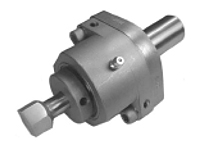Rotary Broach Holders

Rotary Broach Holders
Rotary broaching, also known as wobble broaching, is a fast and accurate method of producing internal and external polygon forms on the end of a workpiece.
- also referred to as "Wobble", "Blind Hole", "Punch" and "Rotary" Broaches
The Rotary Broach Tool Holder can be used on any CNC, Swiss, milling, screw or other turning machine.
The Rotary Broach Tool Holder has an internal live spindle which holds an end cutting broach tool.
| EDP No. | Description | OAL | Shank Diameter | Shank Length | Broach Shank Depth |
| HAS.P-67040 | For Broaches with 0.315 Diameter Shanks | 3 27/64" | 5/8" | 1 1/2" | 9/16" |
| HAS.P-67048S | For Broaches with 0.315 Diameter Shanks | 3 59/64" | 3/4" | 2" | 9/16" |
| HAS.P-67048 | For Broaches with 0.500 Diameter Shanks | 4 17/32" | 3/4" | 2" | .742" |
| HAS.P-67064 | For Broaches with 0.500 Diameter Shanks | 4 17/32" | 1" | 2" | .742" |
| HAS.P-67068 | For Broaches with 0.500 Diameter Shanks | 5 17/32" | 1 1/4" | 3" | .742" |
| HAS.P-67072 | For Broaches with 0.500 Diameter Shanks | 5 17/32" | 1 1/2" | 3" | .742" |
| HAS.P-67072HDS | For Broaches with 0.750 Diameter Shanks | 7 9/16" | 1 1/2" | 3" | 1.250" |
| HAS.P-67076HD | For Broaches with 0.750 Diameter Shanks | 7 9/16" | 1 3/4" | 3" | 1.250" |
Applications

ROTARY/PUNCH BROACHES can be used in a variety of machines to
cut polygons in
blind holes: Any type of CNC or manual turning, milling, drilling
or screw machine.
The practical forming length of rotary/punch broaching is usually
up to 1-1/2 times
the size of the broach (measured across flats).
ROTARY BROACH HOLDERS: For optimal tool life in large production
settings these
broaches are used in Rotary Broach Holders. Holders and broaches
are sold separately
and available from stock for immediate delivery. These holders
are for use on any type
CNC or manual turning, milling, drilling or screw machine. The
holder has an internal
live spindle, which holds the end cutting broach tool. The centerline
of the cutting tool
is offset at 1° from the centerline of the work piece. This
causes the broach to wobble
creating a shearing effect as the broach is advanced into the
work piece or vise versa
as described below:
BROACHING A ROTATING WORK PIECE: In a turning or screw machine,
the holder is
mounted stationary while its internal live spindle and the broach
rotates after contact
with the rotating work piece (Diagram A). At the appropriate feed,
the work piece is
“sheared” by the pressure of the broach through a wobbling
type action producing
the polygon shape desired.
BROACHING A STATIONARY WORK PIECE: In a milling or drilling machine,
the holder is
mounted into and rotates with the machine spindle while its internal
live spindle along
with the broach remains stationary upon contact with the stationary
work piece
(Diagram B). While the machine spindle is rotating, the broach’s
pressure shears the
polygon shape into the work piece (wobbling type action).
PUNCHING VERSUS ROTARY BROACHING: Many applications can be achieved
without
the rotary broach holder. For the purpose of merely punching a
polygon into an
existing pilot hole, these broaches have successfully been used
with universal
machining methods.
Use Recommendations
PART PREPARATION: The diameter of the pre-drilled hole should
be 1-2% larger
than the measurement across the flats on the broach. Drill the
hole as deep
as possible for chip clearance. Countersink with a 90° lead
chamfer slightly
larger than the largest dimension of the broach face (distance
across points).
CENTERING THE BROACH: The most critical component in running these
tools is
having the broach centered as close as possible to the centerline
of the work
piece. Improper centering will cause uneven hole configurations,
oversize
holes, spiraling, and excessive cutter/holder wear. It is necessary
to align the
end of the broach tool to the centerline of the work piece diameter
by
means of adjusting the screws located on the sides of the holder.
Alignment
instructions are included with purchase of the tool holder.
SPEEDS & FEEDS: Rotational speed (RPM) has very little effect
on cutting
speed and tool life. We recommend starting at 1200 RPM with a
feed rate
of .016 times the size of the broach in inches for a feed rate
in IPR units.
For example the feed rate for a 1/4” rotary/punch broach
would be
.016 x .250 = .004”/rev.
COOLANT: The amount of heat generated is minimal. Normal coolant
or cutting
oil should be applied on the tip of the broaching tool prior to
contacting the
work piece and not inside of the work piece pilot hole. Trapped
fluid may
not be able to escape, causing inability to broach to full depth.
BROACH TOOL MATERIAL: Broaches are customarily manufactured from
M-2
high-speed steel. This material provides the required edge toughness
for
standard operations, which do not generate enough heat to effect
tool life
in machining most metals. However, for broaching materials such
as ductile
iron, tool steel, stainless steels, titanium alloys, or nickel-cobalt
alloys, a
cobalt or PM-4 powdered metal broach would be recommended for
optimal
tool life. Coatings are also available.
Trademarks are the properties of their respective owner(s).
